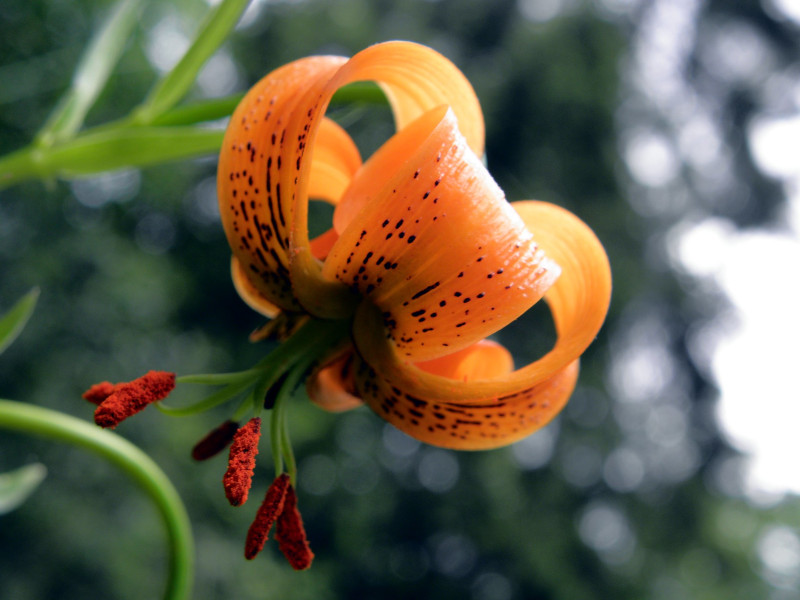
American Tiger Lily Facts
- This stunning variety of true lily most frequently goes by the descriptive and informative common name of the American Tiger Lily. Yet, it also has multiple other general titles it’s sometimes known by. These include such terms as turban lily, swamp lily, and Turk’s cap lily.
- Within the scientific community, however, it’s perhaps much better known by its purely technical designation. Thankfully, that’s a much simpler term for the layperson to pronounce than most such tend to be. That’s because the plant holds the formal tag of Lilium superbum.
- This natural biological beauty received that epithet due to the concerted efforts of Carl Linnaeus. The highly esteemed Swedish biologist accomplished the first recognition of it as a separate and distinct species. He managed that scientifically noteworthy feat in the year 1753.
- In addition to its obvious natural beauty, the amazing flora has long held extremely important cultural significance for several tribes of Indigenous Peoples native to the region. It’s long been deeply incorporated into various tribal folklore, ceremonies, and traditional rituals.
- Fortunately, the breathtaking American Tiger Lily appears to be maintaining a comparatively stable and sufficient population base. That pleasant state also seems to hold true throughout the entirety of its range. It thus does not currently show on the Red List of the IUCN.
- The breathtaking Angiosperm nevertheless still faces several potential threats to its continued existence as a species. In this, however, it but mimics the perils all species on earth now face. Like all of us, it’s now dealing with the dangers of habitat loss and ongoing climate change.
Related Articles
American Tiger Lily Physical Description
Like most of its many relatives around the globe, the fabulous American Tiger Lily rarely fails to capture the attention of those individuals fortunate enough to encounter it. Unlike some of them, however, it doesn’t rely on its great beauty alone. That’s true since it also achieves a significant size.
Typically, each plant produces a single strongly erect, but relatively thin stem. Despite its narrow nature, its quite sturdy. Most achieve an average height ranging between 3 – 8 ft (0.91 – 2.44 m). Under ideals conditions, though, some specimens grow as tall as an astounding 10 ft (3 m).
The primary stem also usually manifests a highly unique combination of attributes. Its surface generally remains quite smooth to the touch, though it does often manifest a slightly mottled appearance. Meanwhile, the shorter stem of the plant’s foliage also shows the same tendencies.
Those same leaves evolved to develop as notably elongated and lance-shaped in design. It’s also most often arranged in whorls around the stem. These appear dark green in color and generally display prominent veins running through them. In length, they often reach up to 6 i (15 cm).
Yet, it’s without doubt the gorgeous blooms of the American Tiger Lily that gather the most interest among most of its viewers. Each stem usually produces between 3 – 7 flowers, but sometimes as many as 40 appear! When open, these measure an average width equaling about 3 in (7.6 cm).
Its color also tends to dazzle the eye of the observer. Intriguingly, this often varies quite widely between individual plants. This ranges from a deep shade of yellow to an reddish-orange shade, often considered a flame-color. The tips of the petals occasionally show slight reddish-purple hues.
- Kingdom: Plantae
- Phylum: Tracheophyta
- Class: Monocots
- Order: Liliales
- Family: Liliaceae
- Genus: Lilium
- Species: L. superbum
American Tiger Lily Distribution, Habitat, and Ecology
The enthralling American Tiger Lily evolved as native to a moderately broad expanse of the earth’s surface. However, its own common name clearly provides a partial indication of that native zone of habitation. That’s because it developed as indigenous to a certain portion of North America.
Yes, as strongly implied by the moniker, that includes the United States. There, though, it primarily appears in the eastern regions. This extends from the costal regions, to as far south as the state of Georgia. To the west, its territory extends roughly to sections of both Minnesota and Missouri.
Northward, however, the marvel of Nature and botanical evolution extends that range as far as southeastern Canada. This area of habitation mainly consists of parts of Ontario. Along the way, though, the botanical beauty remains especially prevalent in the Appalachian Mountains.
Like many lilies found around the world, it displays strong preferences regarding its choices of habitat. In its case, it’s commonly found in habitats with consistently moist or wet conditions. This includes marshes, wet meadows, bogs, and along the banks of streams, rivers, and ponds.
It’s especially fond of swampy areas, most likely due to the specific combination of water-logged soil and extremely high levels of organic matter. Though the flora prefers partial shade, it’s flexible enough to manage in most light levels. It’s quite often found growing under the tree canopy.
The awe-inspiring wonder achieves its pollination via the activities of a truly wide variety of insects. This includes locally prevalent types of beetles, butterflies, and bees, among numerous others. The natural evolutionary design and sheer size of its blooms provide easy access for their visits.
Once pollinated, the amazing American Tiger Lily produces multiple capsules filled with many small seeds. These capsules later split open when ripe, releasing the many seeds. These in turn may be dispersed by wind, water, or animals, helping to colonize new areas within the wetland habitat.
The remarkable plant also plays a vital role in the ecology of wetland ecosystems in often inhabits. The natural marvel does so by providing habitat and food for various organisms. Its foliage frequently offers shelter for small animals, and its flowers provide nectar and pollen for pollinators.
Species Sharing Its Range
Check out our other articles on 4 Washington State Herbaceous Plants, Giant Otter, Komodo Island, Eastern Sweetshrub, Fire Salamander, White-spotted Jellyfish, Shoebill, Orinoco Crocodile
